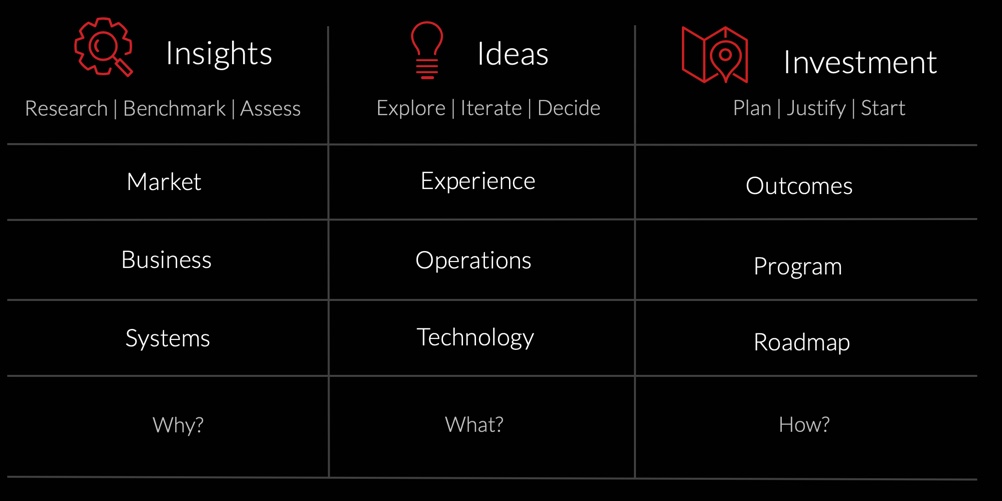As I noted in my previous post there is a gap in strategy that occurs between the business strategy and the implementation of a variety of initiatives. I want to discuss how we at Perficient have chosen to fill it. The approach we take has actually been honed over a period of years and even now continues to evolve. It evolves as we discover better ways to align the approach and as we move from business need to business need.
When you address the gap, you shouldn’t launch into your plan. As a matter of fact, we end up with a roadmap only after gathering additional information. From our perspective a strategic framework, should start with three components
- Insights: Where are you now? This includes where you are as a business, what the marketplace looks like and what systems you have in place
- Ideas: What is your vision? What do you want to do? How does that align the new or refined business strategy. This should include ideas or plan on experience, operations, and technology
- Investment: What is your plan? how will you justify it? Where will you start? This should include defined and measurable outcomes, definition of a program, and a roadmap on how to get there.
If we were to draw it out, it would look like this:

The short of this is that you continue to answer the why began in your business strategy but really begin to get into the details with the what and how.
Key Best Practices to This Approach
Every company starts with different needs, different systems, and definitely a different culture. This means that you don’t do the same thing every time. Sometimes you will spend a large amount of time in insights. Sometimes you can leverage a fair amount of existing information and move quickly to ideas. There you might spend more time in defining you technology needs and selecting the right product(s). You will almost always end with a roadmap. Everyone wants to know the steps you plan to take that gets you to your desired outcomes. That said, there are a few things you should always do
- Include more people than you think you should. This isn’t an invitation to talk to everyone. It is a suggestion that you cannot neither develop nor act on a strategy without communication, collaboration, understanding, and buy-in from large parts of your organization. Developing your plan in a silo will guarantee failure.
- Think about more than technology. I could say think about more than operations or organization but the best practice remains the same. Take a holistic approach. You may have a great strategy and approach but the actions of your competitors must be taken into account. Our Digital Strategy team has a great approach in this with Now, New, Next. It’s worth a read. In each phase of your strategy, look at all the elements and make a determination if you have sufficient understanding and if you have covered it well.
- Make Decisions. It is better to make decisions that are mostly right than to fail to decide at all. Define your vision and move forward.
- Measure. Every single initiative I see incorporates some aspect of data. Data has value. It has value in giving you insights that lead to actions. It has value in that you can sell it the insights to your customers. It has value to you if you choose to measure your baseline to start. Don’t be afraid to define your KPI’s. They may point to failure but if they do, you still have plenty of time to course correct. Far better to do a course correction early than reach the end of your plan with nothing to show for it.
- Be agile. You should be agile in every phase of your strategy. You should be agile with your roadmap as well. Earlier this year we created a marketing roadmap for a healthcare organization. We delivered it shortly before Covid 19 hit and a few months before they inked a large deal with another company that would have expanded their current footprint by 10x. Their roadmap changed. Because we were agile, we could help them react to the changes and focus on the outcomes they wanted.
Next
I’ll finish this off with a deeper dive into what you might do in each phase of this strategic framework.